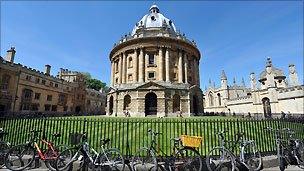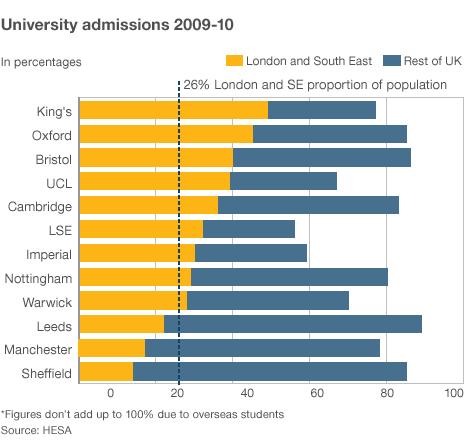North-south divide in university admissions
- Published

Are "intensively parented" London teenagers grabbing all the places?
Social mobility and university access are under the microscope again, with the Sutton Trust looking at whether independent school pupils are disproportionately dominating places at top universities.
But what happens if instead of looking at the type of school students come from, you look at where they live?
Admissions figures from the Higher Education Statistics Agency and individual universities show that youngsters from London and south-east England are more likely to gain places at England's top universities than their northern counterparts.
Figures for Oxford and Cambridge show that more southerners apply and a higher proportion get places.
In terms of comparable populations, three times as many places go to students from London and the South East as from the North.
When the data is broken down even further, there are some stark figures. At Oxford University more students from China gained places than from north-east England.
Does this mean that the pushy southerners are grabbing all the places? Or is it a case of what's diplomatically described as "intensively parented" London teenagers taking all the prizes?
Top universities, which spend large amounts of time, money and goodwill trying to "widen participation", are likely to sigh wearily at another round of accusations of being socially exclusive.
But what about regional exclusivity? What do the figures tell us about the map of modern England and the wider UK?
In terms of who gets university places, "geography is a better predictor than social class or income", says Professor Danny Dorling of the University of Sheffield and an expert on the north-south divide.
"You're more likely to be able to tell a pathway from a postcode."
Outnumbered
In terms of the overall population of the UK, about three quarters live outside London and south-east England.
But when it comes to getting places at some top universities, the majority becomes a minority.
At Bristol, Cambridge, Imperial, King's College, Oxford, Southampton and Warwick, students from outside the capital and South East are in a minority, according to figures from the Higher Education Statistics Agency.

A higher proportion of top A-level results are gained in London and the South
Overseas students are also now a major part of the student population, overtaking numbers of northern students in some top universities.
At the London School of Economics, UK students from outside London and the South East make up less than 25% of the undergraduate intake. More than 40% are international students.
London and the South East are similar in population size to the combined northern regions of the North East, North West, Yorkshire and Humberside.
But according to entry figures for 2010, northern applicants gained just over 800 Oxbridge places, compared with almost 2,700 taken by students from London and the South East.
There are also over-representations compared with the wider university population. About 26% of university admissions are from London and the South East, but the Oxbridge figure is above 40%.
Regional A-level gaps
There are reasons for such an imbalance. The top universities draw their students from among those with the highest exam grades.
Oxford University has argued that it can only choose from the best candidates who apply - it can't put right the inequalities in the school system.
Oxford University has outreach projects, summer schools and spends £8m a year in support schemes - and still gets bashed every year for recruiting too narrowly.
It even gets blamed for using the figures it publishes to show that it is transparent in its admissions.
And the figures show the regional geography of educational winners and losers.
In London and the South East a higher proportion of pupils achieve three A grades at A-level - and it follows that pupils from this part of the country will gain more of the most sought-after places.
According to figures from Oxford, about 6,000 students in the North get AAA grades at A-level each year, together with 3,700 in the Midlands - compared to 15,700 from the South and East.
Oxford also points out that many students prefer to attend a university reasonably close to home.
There is also a well-established link between family income and academic achievement - so the greater concentration of wealthier families in the South East and London is reflected in university admissions.
Fitting in
But are there other cultural barriers as well? Perceptions about "fitting in" can be very influential, suggests Frank Furedi, author and professor of sociology at the University of Kent.
He describes a "phenomenally bright" student he knew from north Wales who was offered a place at Oxford but turned it down because "she thought she wouldn't feel comfortable... that it was for southerners".

More students from China got Oxford places this year than from the north-east of England
Applying to the top universities can depend on "cultural capital", he says. And this can blur the boundaries of state and private education.
"There might be Islington parents with very strong views on independent schools - but who are still part of the mushrooming of private tuition."
These families, with their "intensive parenting", prepare their children to succeed in exams and find university places, he says.
There are other population shifts widening the north-south gap.
The employment market, with more graduate jobs in and around London, brings young university-leavers southwards.
When these graduates settle down and have families, they in turn influence the ambitions of their children, says Professor Dorling.
"Graduates want their children to go to university - and in London and the South East there are a lot of graduates' children," he says.
Aspiring immigrants
Another driving force is that immigrants coming to London, regardless of their own income, are more likely to have aspirations to get their children into university.
And at the top end of the wealth bracket in London, there is a highly-ambitious metropolitan elite leading the chase for the most sought-after places for their children.
Looking at social mobility in terms of private and state schools can also overlook competitive, league-topping, oversubscribed state schools - the type that ring London and its commuter belt.
The admissions data from the Sutton Trust shows some comprehensives in London and the home counties are much more successful than many independent schools at getting pupils into the top universities.
Looking at the comprehensives gaining the most places at the most selective universities, seven out of the top 10 are in the London and the surrounding area.
Among grammar schools getting the highest proportion of places in the most selective universities, nine out of the top 10 are in southern England.
The Sutton Trust says state pupils in Reading, Hammersmith and Fulham, Sutton and Buckinghamshire are more than 50 times as likely to be accepted at Oxford or Cambridge than pupils in Rochdale, Knowsley or Sandwell - and also the inner-London borough of Hackney.
Bucking the trend
But it is not a one-dimensional picture.
There are leading northern universities where the southern contingent is lower than their proportion of the national population, such as Sheffield, Manchester and Leeds.
There is also a distinctly different pattern outside England, with universities such as Glasgow and Queen's Belfast drawing students from Scotland and Northern Ireland.
The Social Mobility Foundation's chief executive, David Johnston, said that young people from under-represented backgrounds face similar barriers, wherever they live.
"As with all under-represented groups, if you have fewer people from your particular background who are students or academics at such universities, you have fewer people who can share how they made it."

- Published28 June 2011
- Published15 April 2011
- Published11 February 2011